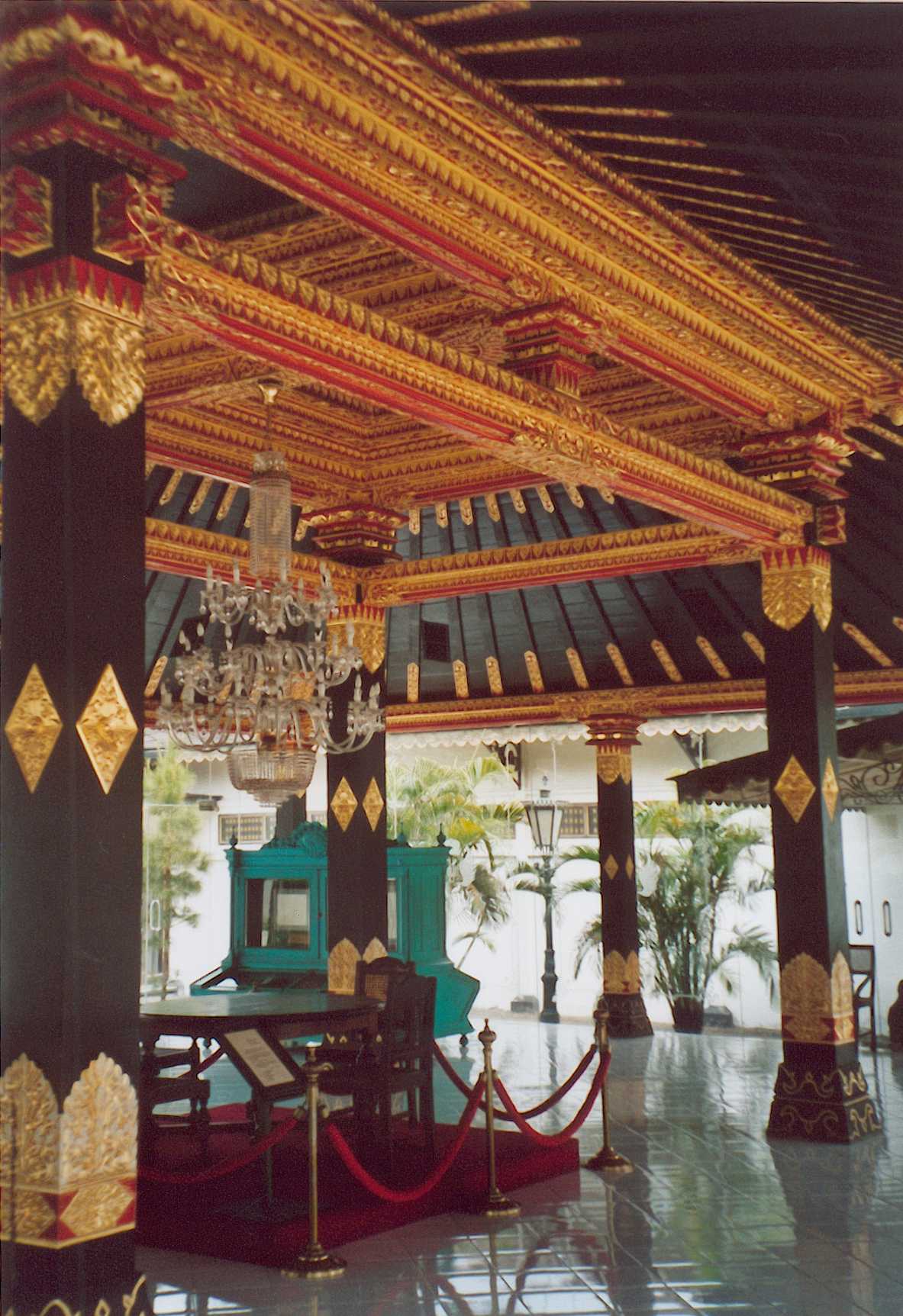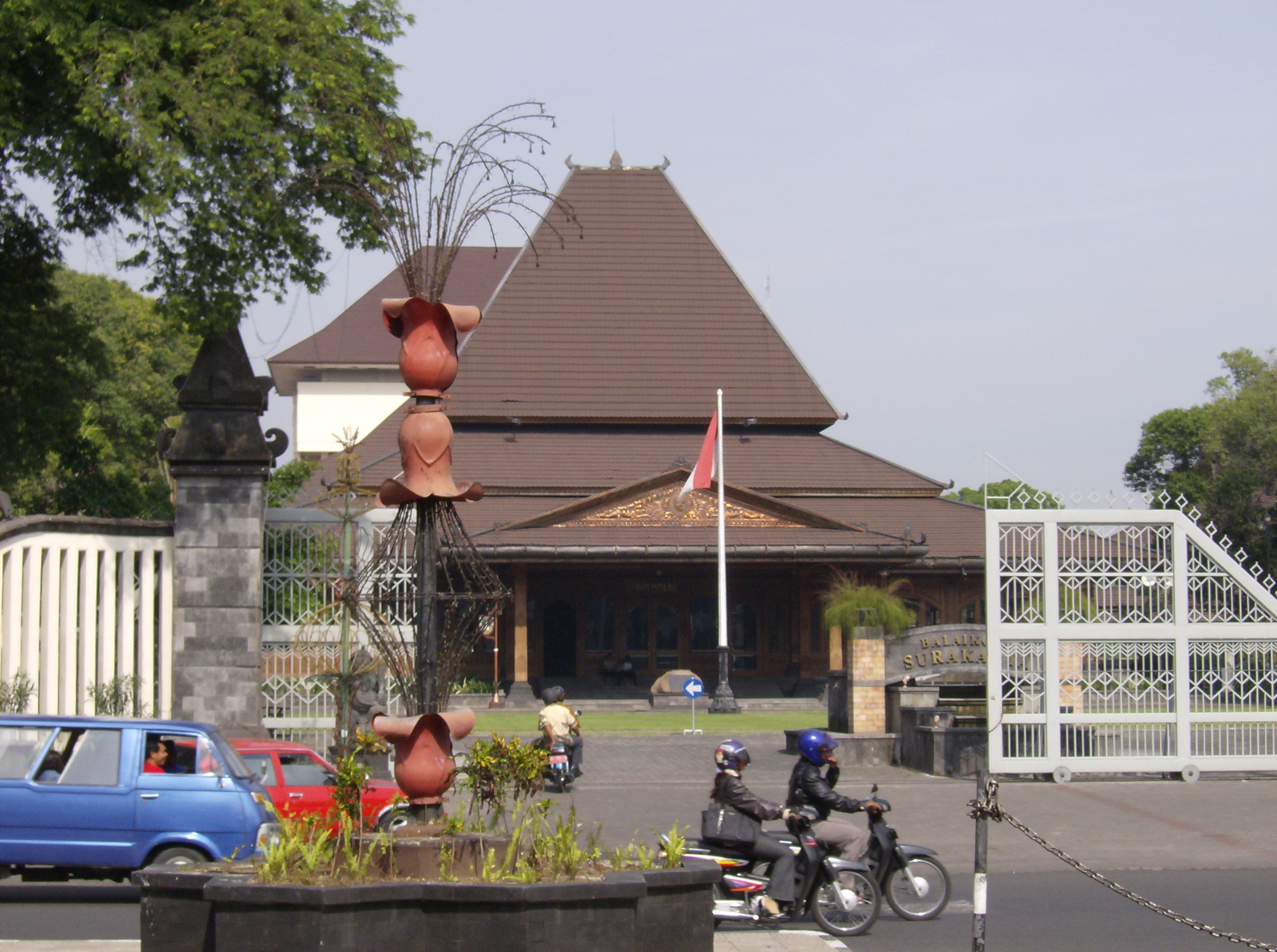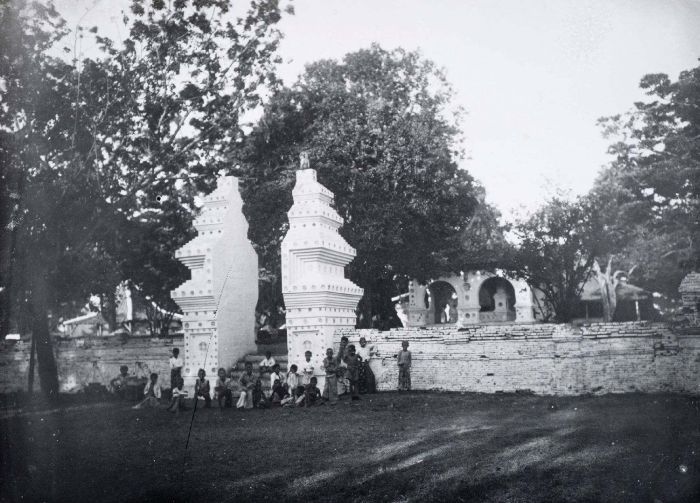|
Keraton
Kraton or keraton ( jv, ꦏꦿꦠꦺꦴꦤ꧀ or ꦏꦼꦫꦠꦺꦴꦤ꧀) is a type of royal palace in Java, Indonesia. Its name is derived from the Javanese ''ka-ratu-an'', meaning residence of the ''ratu'', the traditional honorific title for a monarch. In Java, the palace of a prince is called ''pura'' or ''dalem'', while the general word for palace is ''istana'', identical to Malay. Specific palaces Kraton that function as the residence of a royal family include: ;Yogyakarta (Jogja) region: *Kraton Ngayogyakarta Hadiningrat (Palace of Sultan Hamengkubuwono). *Pura Pakualaman (Palace of Adipati Pakualam). ;Surakarta (Solo) region: * Kraton Surakarta Hadiningrat (Palace of Susuhunan Pakubuwono). * Pura Mangkunegaran (Palace of Adipati Mangkunegara). ;Cirebon area: * Kraton Kasepuhan (Palace of Sultan Sepuh). * Kraton Kanoman (Palace of Sultan Anom). * Kraton Kacirebonan (Palace of Sultan Cirebon). * Kraton Kaprabonan ( id) (Palace of Sultan Prabon). Historical palaces ... [...More Info...] [...Related Items...] OR: [Wikipedia] [Google] [Baidu] |
Kraton Kacirebonan
The Kraton Kacirebonan is the oldest Kraton (sultan's palace) in the Indonesian city of Cirebon. It has existed since 1807. This colonial building has housed many historical relics such as Keris, Wayang puppets, war equipment, Gamelan instruments and others. Kacirebonan in the area of the District Pulasaren Pekalipan village, exactly 1 kilometer southwest of Kasepuhan Palace and approximately 500 meters south of Keraton Kanoman. Kraton Kacirebonan is positioned from north to south (as are the other palaces in Cirebon) with a land area of about 46,500 square meters. History History begins when Prince Sultan Kacirebonan King Kanoman, heir to the throne of the Sultanate Kanoman joined the people of Cirebon in rejecting taxes applied by Holland. Application of these taxes led to the revolt of the people in some places. As a result, Prince Raja Kanoman was captured by the Dutch and thrown into the fortress Viktoria in Ambon, stripped of his title, as well as deprived as Sultan Kan ... [...More Info...] [...Related Items...] OR: [Wikipedia] [Google] [Baidu] |
Ratu Boko
Ratu Boko ( jv, Ratu Baka) or Ratu Boko Palace is an archaeological site in Java. Ratu Boko is located on a plateau, about three kilometres south of Prambanan temple complex in Yogyakarta, Indonesia. The original name of this site is still unclear, however the local inhabitants named this site after King Boko, the legendary king mentioned in Roro Jonggrang folklore. In Javanese, ''Ratu Boko'' means "Stork King". The site covers 16 hectares in two hamlets (''Dawung'' and ''Sambireja'') of the village of Bokoharjo and Prambanan, Sleman Regency. In striking contrast to other Classic-period sites in Central Java and Yogyakarta, which are remains of temples, Ratu Boko displays attributes of an occupation or settlement site, although its precise function is unknown. Probably the site was a palace complex which belonged to the kings of Sailendra or Mataram Kingdom that also built temples scattered across the Prambanan Plain. The argument was based on the fact that this complex was not ... [...More Info...] [...Related Items...] OR: [Wikipedia] [Google] [Baidu] |
Surakarta
Surakarta ( jv, ꦯꦸꦫꦏꦂꦠ), known colloquially as Solo ( jv, ꦱꦭ; ), is a city in Central Java, Indonesia. The 44 km2 (16.2 sq mi) city adjoins Karanganyar Regency and Boyolali Regency to the north, Karanganyar Regency and Sukoharjo Regency to the east and west, and Sukoharjo Regency to the south. On the eastern side of Solo lies Solo River (Bengawan Solo). Its built-up area, consisting of Surakarta City and 59 districts spread over seven regencies ("Greater Solo Area", formerly Special Region of Surakarta), was home to 3,649,254 inhabitants as of 2010 census, around half million of which reside in the city proper. Surakarta is the birthplace of the current President of Indonesia, Joko Widodo. He served as Mayor of Surakarta from 2005 to 2012. History Hominid habitation in the region of Surakarta is evidenced from roughly one million years ago, the age of the " Java Man" skeleton found 80 kilometers upstream. Another famous early hominid from this area i ... [...More Info...] [...Related Items...] OR: [Wikipedia] [Google] [Baidu] |
Kraton Ngayogyakarta Hadiningrat
The Royal Palace of Yogyakarta ( id, Keraton Ngayogyakarta Hadiningrat, jv, ꦏꦿꦠꦺꦴꦤ꧀ꦔꦪꦺꦴꦒꦾꦏꦂꦠꦲꦢꦶꦤꦶꦔꦿꦠ꧀) is a palace complex in the city of Yogyakarta, Yogyakarta Special Region, Indonesia. It is the seat of the reigning Sultan of Yogyakarta and his family. The complex is a center of Javanese culture, and contains a museum displaying royal artifacts. It is guarded by the Yogyakarta Kraton Guards ( Indonesian: ''Prajurit Keraton Ngayogyakarta Hadiningrat''). History The complex was built in 1755–1756 ( AJ 1682) for Hamengkubuwono I, the first Sultan of Yogyakarta.OBYEK PENELITIAN http://elib.unikom.ac.id/ It was one of the monarch's first acts after the signing of the [...More Info...] [...Related Items...] OR: [Wikipedia] [Google] [Baidu] |
Ratu
''Ratu'' () is an Austronesian title used by male Fijians of chiefly rank. An equivalent title, ''adi'' (pronounced ), is used by females of chiefly rank. In the Malay language, the title ''ratu'' is also the traditional honorific title to refer to the ruling king or queen in Javanese culture (though it has since been used in modern contexts to refer to queen regnants of any nation, e.g. "Ratu Elizabeth II"). Thus in Java, a royal palace is called "'' keraton''", constructed from the circumfix ''ke- -an'' and ''Ratu'', to describe the residence of the ratu. Etymology ''Ra'' is a prefix in many titles (''ramasi, ramalo, rasau, ravunisa, ratu''), and ''tu'' means simply "chief". The formal use of "ratu" as a title in a name (as in "Sir" in British tradition) was not introduced until after the cession of 1874. Until then, a chief would be known only by his birth name and his area-specific traditional title. Regional variations include ''ro'' in Rewa and parts of Naitasiri and ... [...More Info...] [...Related Items...] OR: [Wikipedia] [Google] [Baidu] |
Kraton Kaprabonan , an old and stable part of the continental crust, formerly spelled ''kraton''
{{Disambig, geo ...
Kraton may refer to: *Kraton (Indonesia), an Indonesian name for ''palace'' * Kraton, East Java, a subdistrict located in Pasuruan Regency, East Java, Indonesia * Kraton, Yogyakarta, a subdistrict located in Yogyakarta, Special Region of Yogyakarta, Indonesia *Kraton (polymer), a family of polymers produced by Kraton Corporation *Craton A craton (, , or ; from grc-gre, κράτος "strength") is an old and stable part of the continental lithosphere, which consists of Earth's two topmost layers, the crust and the uppermost mantle. Having often survived cycles of merging and ... [...More Info...] [...Related Items...] OR: [Wikipedia] [Google] [Baidu] |
Kraton Kasepuhan
The Kraton Kasepuhan is the oldest kraton (sultan's palace) in the Indonesian city of Cirebon. It is the residence of the Sultan of Kasepuhan and the royal palace of Sultanate of Cirebon. History It was built in 1447 and its architecture and interior are a blend of Sundanese, Javanese, Islamic, Chinese and Dutch styles. While the sultan still lives in the palace, several main sections are open to the public. Inside is a pavilion with white-washed walls dotted with blue-and-white Delft tiles, a marble floor and ceiling hung with French chandeliers. The legacy of Majapahit is preserved in its small '' pendopo'' on soft carved brick bases. The carvings on the ''pendopo'' columns are 1940s copies of the ancient originals. An innovation is the use of brackets branching out from the columns. The main building features unusually tall pyramidal column bases. The ornament on the double braces of this building's ''pendopo'' '' tumpang sari'' ceiling are picked out in gilt. Anoth ... [...More Info...] [...Related Items...] OR: [Wikipedia] [Google] [Baidu] |
Kraton Kanoman
Kraton Kanoman is a palace in the Indonesian city of Cirebon in West Java. It was founded by Sultan Anom I in 1677. In the outer area of the palace, the ''siti inggil'', are masonry versions of the classic Javanese '' pendopo'' form, as opposed to the more conventional timber structures. Like the Great Mosque in Demak, Chinese ceramics are embedded into the plastered walls. The squat split-gates with pyramidal peaks are a Cirebon emblem. See also * Indonesian architecture * Sultanate of Cirebon * List of monarchs of Java * List of palaces in Indonesia This is list of palaces in Indonesia. Seven out of them are presidential palace. References {{Reflist Palaces in Indonesia, * Lists of buildings and structures in Indonesia, Palaces Lists of tourist attractions in Indonesia, Palaces List ... References * Schoppert, P., Damais, S., ''Java Style'', 1997, Didier Millet, Paris, pp. 46–47, Buildings and structures in Cirebon Palaces in Java Tourist attractions in ... [...More Info...] [...Related Items...] OR: [Wikipedia] [Google] [Baidu] |
Jogja
Yogyakarta is the capital city of Special Region of Yogyakarta and the former capital of Indonesia. Yogyakarta may also refer to: * Yogyakarta International Airport * Yogyakarta Principles, a document about human rights with regard to sexual orientation * Special Region of Yogyakarta, a province in Indonesia. * Yogyakarta Sultanate, a Javanese monarchy in Yogyakarta Special Region See also * {{geodis ... [...More Info...] [...Related Items...] OR: [Wikipedia] [Google] [Baidu] |
Pura Mangkunegaran
The Pura Mangkunegaran (, ) is a palace complex in the city of Surakarta, Central Java, Indonesia. It is the official palace and residence of the Duke of Mangkunegara and his family. The palace complex is one of the centers of Javanese culture and contains a museum exhibiting royal artifacts of Mangkunegaran. History The palace complex was built in 1757 ( AJ 1690) following the style of Kraton by the command of Mangkunegara I, the first Duke of Mangkunegaran. This royal palace was built after the Treaty of Salatiga was signed by Mangkunegara I, Hamengkubuwana I, Pakubuwana III, and the VOC on March 1757. The treaty initiated the creation of the Duchy of Mangkunegaran and the investiture of Mangkunegara I as the first ruler. Like any other palaces in Java, The Pura Mangkunegaran had experienced several renovation, rejuvenation, changes on its parts and structures, and also addition of popular European style on its architecture during the Dutch colonization. Architectur ... [...More Info...] [...Related Items...] OR: [Wikipedia] [Google] [Baidu] |
Prambanan
Prambanan ( id, Candi Prambanan, jv, ꦫꦫꦗꦺꦴꦁꦒꦿꦁ, Rara Jonggrang) is a 9th-century Hindu temple compound in Special Region of Yogyakarta, Indonesia, dedicated to the Trimūrti, the expression of God as the Creator (Brahma), the Preserver (Vishnu) and the Destroyer (Shiva). The temple compound is located approximately northeast of the city of Yogyakarta on the boundary between Central Java and Yogyakarta provinces. The temple compound, a UNESCO World Heritage Site, is the largest Hindu temple site in Indonesia and the second-largest in Southeast Asia after Angkor Wat. It is characterized by its tall and pointed architecture, typical of Hindu architecture, and by the towering central building inside a large complex of individual temples. Prambanan temple compounds originally consists of 240 temple structures; which represents the grandeur of ancient Java's Hindu art and architecture, also considered as a masterpiece of the classical period in Indonesia. Prambana ... [...More Info...] [...Related Items...] OR: [Wikipedia] [Google] [Baidu] |






